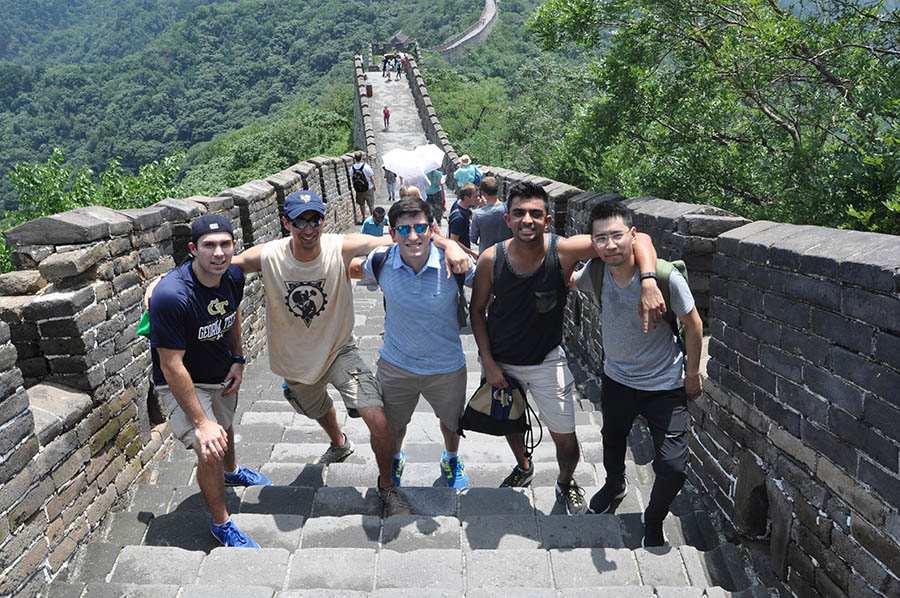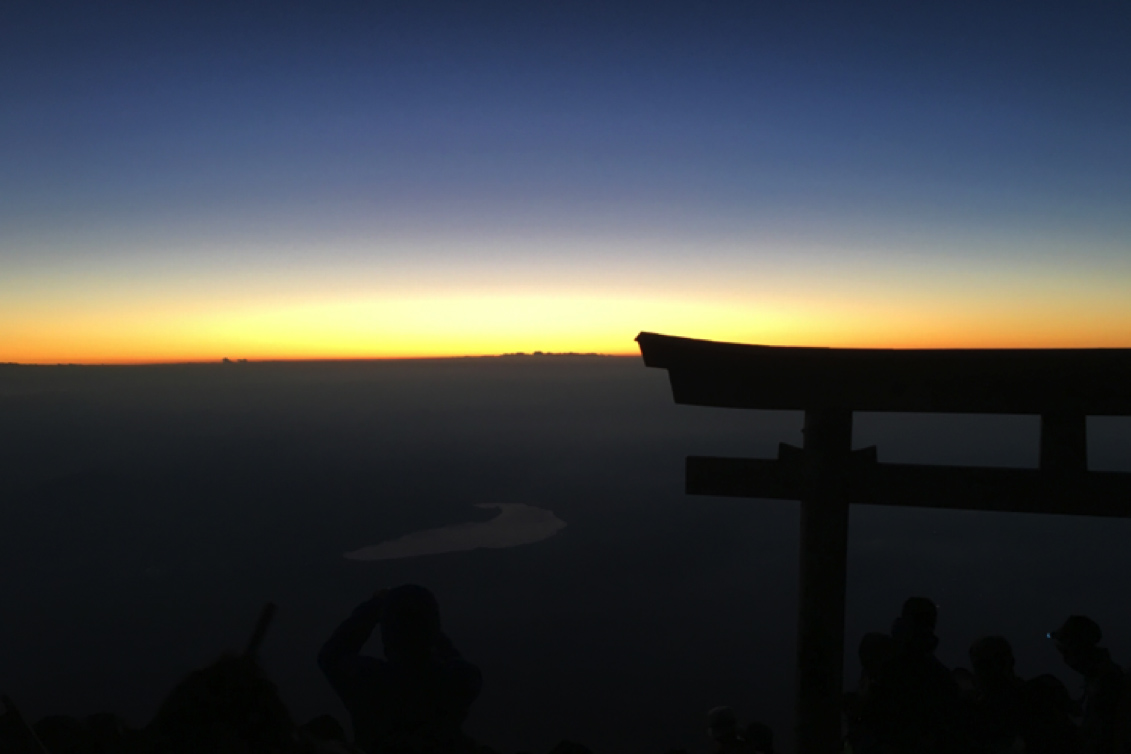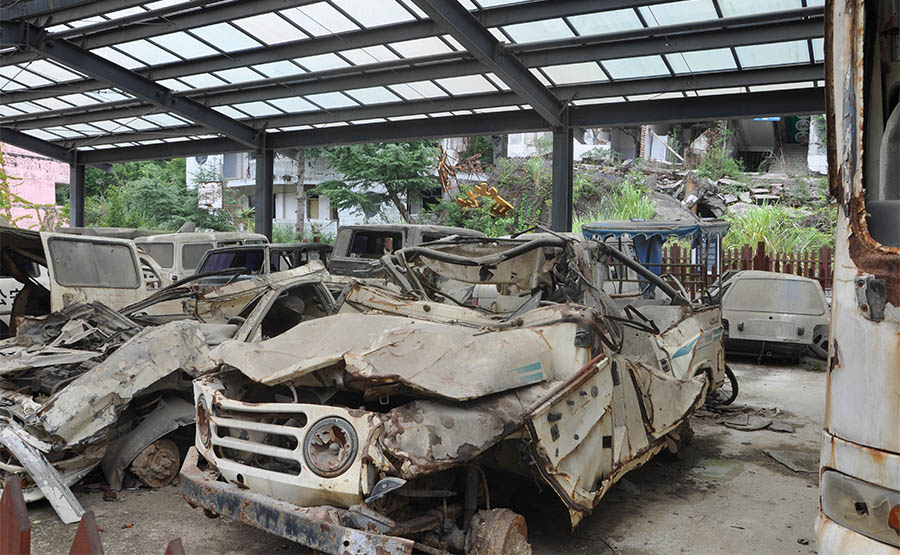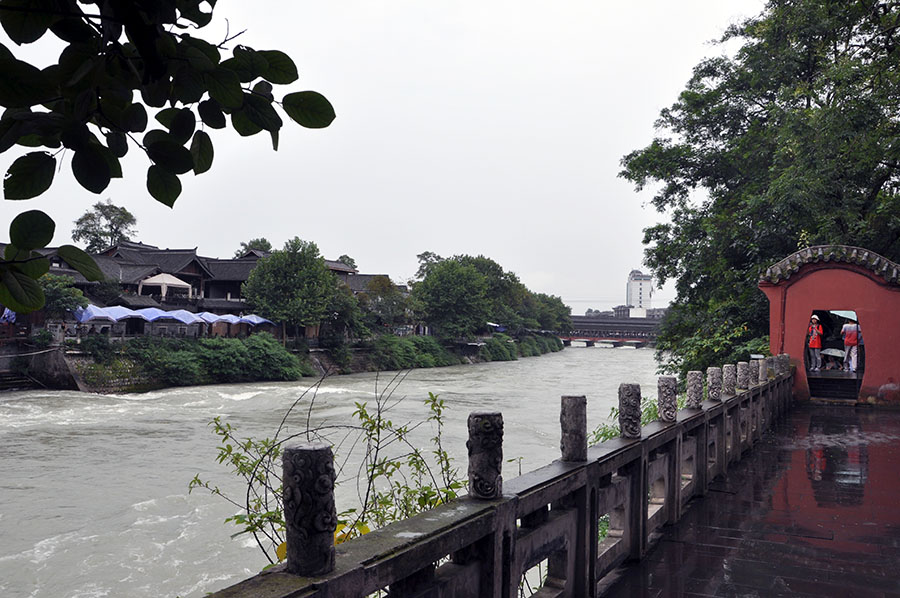 The International Disaster Reconnaissance Studies class on the Great Wall of China, one of their first stops during their two-week trip to China and Japan. From left, civil engineering master’s student Kieron McCarthy, undergrads Donald Smith and Ramiro Santana, industrial engineering undergrad Raghav Srinath, and civil engineering Ph.D. student Fangzhou “Albert” Liu. (Photo: David Frost) |
They climbed the Great Wall of China and explored the Forbidden City.
They visited a town destroyed by an earthquake then preserved as a monument to the lives lost.
They saw baby pandas and flood control systems, Japanese towns devastated by a tsunami and the Hiroshima memorial.
But in the end, it was the relationships they built and an overnight summit of Mt. Fuji in Japan that etched this trip into the memories of four engineering students who traveled to China and Japan in early August.
|
MORE: coordinates.ce.gatech.edu On our student travel blog Coordinates you can see more pictures and read more stories from the trip, including the group’s visit to a panda sanctuary. |
The trip was part of a new course, International Disaster Reconnaissance Studies, taught by David Frost and created as part of the School of Civil and Environmental Engineering’s global engineering leadership minor. By all accounts, it was a whirlwind of learning about disaster engineering, sightseeing, and cultural immersion.
“It was all the things they say about going to college and experiencing something different and new. It was all of that shotgunned at you,” said master’s student Kieron McCarthy. “It was international travel, it was meeting new people, it was problem-solving. I’m not a big arts guy or language guy, but it was arts, language, history, culture.
“At the same time, you benefit from it because you do engineering, science, math.”
“It’s an experience we’ll never forget,” said senior Ramiro Santana. “I’d never been to an area where an earthquake or tsunami had come by.”
“It made me more conscious of how much damage a natural disaster can cause,” he said.
“I’ve been wanting to go [to Asia] for a long time, because all you really know about China, for instance, is just what you read in the news or hear on TV, which isn’t always good,” said fellow undergrad Donald Smith. “It was nice to actually interact with people, regular people.”
Smith is pursuing the global engineering leadership minor, and we’ll get to why that’s important to him in a minute. But let’s go back to this group’s overnight summit of Mt. Fuji.
 The sunrise from the top of Mt. Fuji in Japan. The students in the International Disaster Reconnaissance Studies class hiked all night to reach the top of the mountain in time for this view. (Photo: Kieron McCarthy) |
In the days after the trip, each one mentioned the impact that experience had on them.
“That was a task I think we all underestimated,” McCarthy said. After all, the climb to the top of Japan’s tallest mountain requires no special hiking gear. “I thought, ‘How hard can it be?’”
Hard. That’s the answer to McCarthy’s question. Hard.
Most people climb the mountain over the course of two days — ascending most of the way one day, stopping at a hiking station to sleep for a few hours, and then climbing the rest of the way early the next morning to reach the peak by sunrise. All told, guides say the climb takes anywhere from five to 10 hours.
McCarthy, Santana, Smith and their fourth classmate, Raghav Srinath, did it in about three hours, and that was after 20 hours of planes, trains and taxis from China to the base of the mountain.
“I’d never gone hiking ever in my life,” Santana said.
“It was so difficult. There were so many times I felt like I met my limit. But I kept going. I learned that sometimes you’ll meet you limit, but you just have to keep striving, keep going for it, and hopefully you’ll meet that goal at the end. And it was all worth it: We got there right in time for the sunrise, and it was one of the best views I’ve seen throughout my life.”
“Seeing the sunrise from the top of Mt. Fuji, a peak that iconic? Absolutely [worth it],” Smith said. “There were thousands of people up there with us, too. There were clouds on the horizon, but as soon as the sun started to peek over that cloudbank, everyone started shouting in different languages. It was such a cool experience, sharing that with other people.”
 This building in Old Beichuan, China, performed well structurally in a 2008 earthquake, but its base failed as a result of the ground motion. It remains tilting heavily to one side in the city, which has been turned into a memorial for the thousands of people who died in the ‘quake and subsequent landslides and flood. (Photo: Donald Smith) |
Shifting ground
The Mt. Fuji climb came near the end of two weeks of travel that included lectures from engineers in China and Japan and visits to some of the countries’ engineering solutions to disaster-related problems.
That included the town of Old Beichuan, a community of roughly 21,000 in Sichuan Province that was destroyed by an earthquake and subsequent landslides and flooding in 2008.
 |
 |
|
Top: A memorial plaque in the Chinese city of Old Beichuan. An earthquake and subsequent landslides and flooding nearly destroyed the town in 2008. Half of the city’s 21,000 residents died in the disaster. (Photo: Donald Smith) Bottom: The remnants of vehicles in Old Beichuan. (Photo: Ramiro Santana) |
Rather than rebuild, the Chinese government decided to preserve the city as a memorial and move the community 15 miles south and build a new town, New Beichuan.
McCarthy said that had him thinking a lot about the far-reaching impacts of engineering decisions.
“When making recommendations as an engineer, though it isn’t your job to make recommendations based on the cultural or long-term effects on the economy or the productivity of an area — it’s your job to make the engineering call, which would be that’s safe or not safe, that would work or won’t work — I think it’s still important to take into account those things,” he said.
“Long term, what kind of things do we need to think about that will ultimately improve this community? I took a lot of that away from the trip. Engineers have a lot of effect on others’ decisions.”
Smith said the flood control systems in Sichuan stood out to him, an amazing testament to the skills of engineers millennia ago.
“It’s over 2,000 years old and it still functions the way it did [originally],” he said. “That blew my mind, that they were constructing things like that thousands of years ago. I think ancient Chinese construction could rival the Egyptians, honestly. It still functions to this day, it still provides flood control and water to the capital city in that province, Chengdu.”
 The ancient Dujiangyan flood control system in China’s Sichuan Province, which has operated successfully and continuously since its completion more than 2,000 years ago. (Photo: Ramiro Santana) |
Shifting perspectives
Smith, who transferred the Georgia Tech a year ago to complete his engineering studies, has also started working on his minor in global engineering leadership. He said he expects leadership skills to be essential once he’s a practicing engineer, and the minor gives him a chance to focus on developing those skills in an engineering context.
“I felt like leadership was something I needed to work on,” he said. “And this class is a cross-cultural experience, so it put me in a position to interact with people and cultures literally from the other side of the planet. Ideally that will force me to grow.”
The course, and the group’s travel through Asia, also forced him to reevaluate some of his preconceptions about China and Japan, Smith said.
“You get a sense that no matter where you go in the world, normal people are fairly similar,” he said. “We’re all just trying to live our lives, work a job, eat good food, drink clean water. Everyone needs basic engineered necessities of life.”
Santana, no stranger to study abroad after spending last summer in Europe at Georgia Tech-Lorraine, said the trip gave him a chance to see the power of civil engineering in real communities affected by disasters.
“It’s a once in a lifetime experience. You get to travel with the professor and other [Georgia Tech] students, and you get to see this whole area that was impacted by natural disaster,” he said. “It’s a great experience.”
For McCarthy, a Coast Guard officer finishing his master’s and heading back to active duty, the experience was also about connecting with his classmates and understanding their perspectives.
“I was able to bounce ideas off someone who was born and raised in India, someone who was born and raised in Puerto Rico. So when I see something, I’m like, what do you think? Do you think they did that for this reason? That reason? It was awesome to bounce that off someone,” McCarthy said.
“We basically talked for two weeks. I learned a lot from the other guys.”

